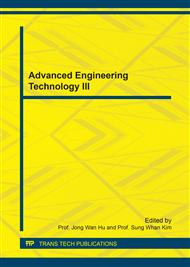p.259
p.263
p.270
p.275
p.282
p.289
p.295
p.301
p.306
Optimization of Concrete Porous Mix Using Slag as Substitute Material for Cement and Aggregates
Abstract:
In recent years, sustainability and environmental effect of concrete became the main concern. Substituting cement with the other cementitious material without decreasing mechanical properties of a mixture could save energy, reduce greenhouse effect due to mining, calcination and limestone refining. Therefore, some industrial by-products such as fly ash, silica fume, and Ground Iron Blast Furnace Slag (GIBFS) would be used in this study to substitute cement and aggregate. This substitution would be applied on the porous concrete mixture to minimize the environmental effect. Slag performance will be optimized by trying out variations of fly ash, silica fume, and slag as cement substitution material in mortar mixture. The result is narrowed into two types of substitution. First, reviewed from the fly ash substitution effect on binder material, highest compressive strength 16.2 MPa was obtained from mixture composition 6% fly ash, 3% silica fume and 17% grinding granular blast-furnace slag. Second, reviewed from slag types as cement substitution and silica fume substitution, highest compressive strength 15.2 MPa was obtained from mortar specimens with air-cooled blast furnace slag. It composed with binder material 56% Portland composite cement, 15% fly ash, 3% silica fume and 26% air-cooled blast furnace slag. Considering the cement substitution, the latter mixture was chosen.
Info:
Periodical:
Pages:
282-288
Citation:
Online since:
June 2017
Authors:
Keywords:
Price:
Сopyright:
© 2017 Trans Tech Publications Ltd. All Rights Reserved
Share:
Citation:


